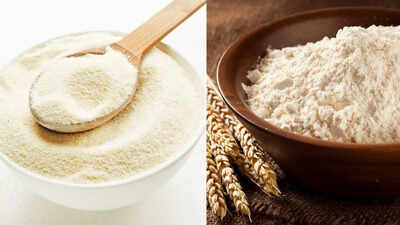Sooji (semolina) and wheat are two of the most commonly used grains in everyday diets, both originating from the same wheat source but differing significantly in processing, texture, and nutritional value. Sooji, made from durum wheat, is often refined and coarser, while whole-wheat flour retains the bran, germ, and endosperm, making it richer in fibre and nutrients. These differences impact how each affects blood sugar, digestion, and weight management. For those focusing on weight loss or diabetes control, the choice between sooji and wheat can significantly influence satiety, energy levels, and glucose balance. Understanding their nutritional distinctions helps make smarter, health-focused food decisions.
Comparing the health benefits of both the grains: Sooji and wheat
Sooji (Semolina)Sooji, also known as semolina, is a coarse flour made from durum wheat. It is widely used in Indian dishes such as upma, halwa, and idlis, and globally in pasta and couscous. Because it is often milled from refined grains, it tends to have a lower fibre content compared with whole-wheat flour.Wheat (Whole-Grain Wheat or Atta)Whole-wheat flour, also called atta, retains all parts of the grain, the bran, germ, and endosperm, making it richer in fibre, vitamins, and minerals. It forms the base for chapatis, breads, and a range of healthy whole-grain dishes.
Nutritional comparison: Sooji vs. Wheat
While both are similar in calorie and carbohydrate content, whole-wheat flour clearly stands out for its higher fibre and nutrient density. The additional fibre slows digestion, keeps you fuller for longer, and helps stabilise blood sugar levels.
Impact on blood sugar control
SoojiSooji has a moderate glycaemic index (GI), meaning it can raise blood sugar levels moderately. Because it is often refined, it digests faster than whole-grain wheat, which may lead to quicker spikes in glucose. However, when cooked with vegetables, protein, and minimal oil, such as in upma or rava dosa, its effect can be moderated.WheatWhole-wheat flour generally has a lower glycaemic impact due to its fibre content, which slows down glucose absorption. The presence of bran and germ also contributes to better insulin response and sustained energy release. People with diabetes or prediabetes often find that switching from refined flours to whole-grain wheat improves blood sugar control over time.For better blood sugar regulation, whole-wheat flour (especially minimally processed varieties) is a superior choice. According to a study published in Nutrition Journal, daily intake of whole grains significantly reduced fasting blood glucose levels and had modest beneficial effects on insulin resistance.
Weight loss and satiety
SoojiSooji is light and easy to digest, which makes it ideal for people with sensitive digestion. However, because it’s lower in fibre, it may not keep you full for long. To make sooji-based meals more weight-loss-friendly, combine them with vegetables, lean proteins, or legumes, for example, a vegetable upma or rava idli with chutney.WheatWhole-wheat flour supports weight management more effectively due to its higher fibre and protein content. Fibre adds bulk, increases satiety, and helps reduce overall calorie intake. Incorporating whole-wheat rotis, porridges, or cracked wheat (dalia) into meals can support sustainable weight loss.For long-term weight control, whole-grain wheat has a clear edge. It promotes satiety and provides steady energy without sudden hunger pangs.
Digestibility and health considerations
Sooji is often easier to digest, making it a good option for those recovering from illness or with mild digestive issues.Whole-wheat flour, while more fibrous, can cause bloating in individuals unaccustomed to high-fibre diets, but this typically improves with gradual inclusion.Both contain gluten, so neither is suitable for those with coeliac disease or gluten intolerance.For blood sugar control:
- Choose whole-grain wheat flour instead of refined varieties.
- If using sooji, pick a coarse, less processed version.
- Combine either grain with high-protein and high-fibre foods such as lentils, vegetables, or seeds.
- Avoid adding excess sugar or fat when cooking.
For weight loss:
- Practise portion control: Both sooji and wheat are calorie-dense.
- Pair whole-wheat dishes with vegetables and lean proteins for balanced meals.
- Enjoy sooji in moderation; a breakfast upma or light dinner option can fit into a balanced plan.
Practical meal ideas
Whole-wheat options:
- Rotis with vegetables and lentil curry.
- Cracked wheat (dalia) porridge with milk and nuts.
- Whole-wheat pasta with tomato and bean sauce.
Sooji options:
- Vegetable upma with peas, carrots, and beans.
- Rava idli with coconut chutney.
- Light sooji porridge with milk for an easy-to-digest breakfast.
Which one should you choose
Both sooji and wheat have their own place in a balanced diet, but their benefits depend on your health goals.For weight loss and blood sugar control, whole-grain wheat (atta) is the better choice due to its high fibre, slower digestion, and improved satiety.Sooji, while lighter and easier to digest, is lower in fibre and best consumed in moderation or as part of a balanced meal.Ultimately, the healthiest approach is variety and moderation, alternating between sooji and wheat-based dishes, ensuring both are paired with nutritious, high-fibre, and protein-rich foods.Disclaimer: This article is for informational purposes only and should not be considered medical advice. Please consult a healthcare professional before making any changes to your diet, medication, or lifestyle.
